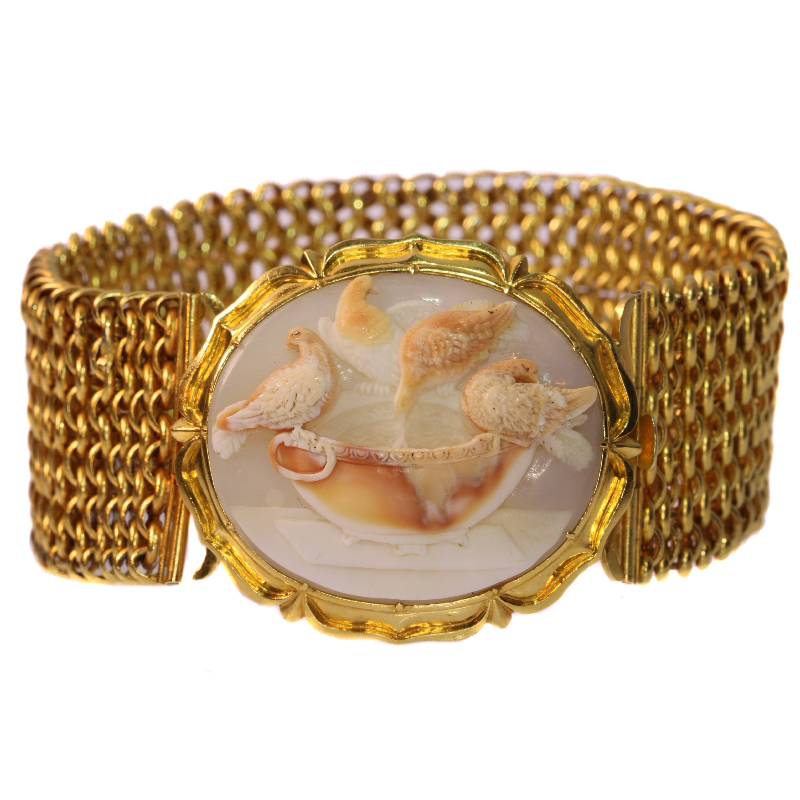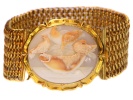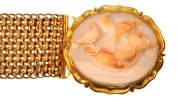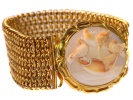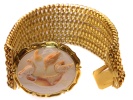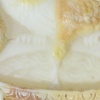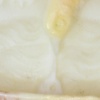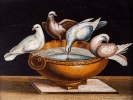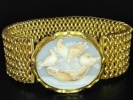Nu gespreide betaling mogelijk op het juweel van uw dromen! Vraag ons naar de details.
Gratis verzekerde verzending van alle orders!
Magnificent antique cameo bracelet with presentation of so-called Doves of Pliny
As three downey doves are sunbathing from the rim of a basin while one is gracefully drinking in this picturesque cameo, this 14K yellow gold bracelet from around 1850 splatters history all over our Garden of Adin.
This exact composition of four plumose pigeons is called "Doves of Pliny" or "Capitoline Doves", which refers to Pliny the Elder as he describes the original picture in a classical mosaic by Sosus of Pergamon dating back from the 2nd century BC. A revival of these archealogical wonders can be seen in the 1st half of the 19th century as it was very popular to reuse this motif in various artefacts. And yet, we have never seen a piece of such superb quality as the one we've got here. To emphasise its excellence, we invite you to closely lean over to the water in the vase and to notice the subtle reflection of the drinking dove. Apart from this meticulous elaboration, it is exactly this particular fragment by which Pliny was as equally mesmerised as we still are today. Only rarely, an artist manages to bring out this section of this iconic image.
Furthermore, this cameo has been engraved in the hardest part of the shell, which provides an even more realistic appearance as there are three different colour layers. Let alone the level of craftmanship needed to sculpt every detail a material as hard as stone, which we believe to take its origin from an Italian hand.
Of course, this piece of artistry can only be brought to its full spectacle in a harmonious mounting, which most probably must have come from an English goldsmith.
Antique jewelry object group: bracelet
Condition: very good condition
- (more info on our condition scale)
Country of origin:
unknown
Style:
Victorian - Victorian decorative arts refers to the style of decorative arts during the Victorian era. The Victorian era is known for its eclectic revival and interpretation of historic styles and the introduction of cross-cultural influences from the
middle east and Asia in furniture, fittings, and Interior decoration. Victorian design is widely viewed as having indulged in a regrettable excess of ornament. The Arts and Crafts movement, the aesthetic movement, Anglo-Japanese style, and Art Nouveau
style have their beginnings in the late Victorian era.
- See also: Victorian
or more info on styles
Style specifics:
The Romantic Victorian Period - Experts divide the reign of Queen Victoria, also called The Victorian era (1837 - 1901) in to three periods of about twenty years each; The Romantic Victorian Period (1837 - 1860), The Grand Victorian Period (1860 -
1880), and the Late or Aesthetic Victorian Period (1880 - 1901).
We consider this to be of the Romantic Victorian Period. This period covers the coronation of Victoria as Queen of Great Britain and Ireland, and her marriage to King Albert and their love, their devotion to their marriage and to their country are the
sources of inspiration for this period. The jewels of this period are made of intricate carvings, special techniques where the enamel is subtly worked. These techniques allowed to give the jewel a certain opulence with less precious metal needed. As
precious metals were really rare at that time. Highly favored (semi-) precious stones in this period are amethyst, coral, garnets, seed pearls and turquoises. The connotation is obviously sentimental, symbolic and romantic with reminiscent Gotic and/or
Renaissance patterns and an abundant use of motifs like anchors, birds, branches, crosses, hearts and snakes.
Period: ca. 1850
- (events & facts of this era, poetry of this era,
fashion of this era)
Source of inspiration: "The doves of Pliny" also called the "Capitoline Doves" (see explanation further in text)
Theme: Doves sunbathing and drinking on a vase.
Material: 14K yellow gold
(looking at the color this could be 15K too, but since we can only make the difference between 14K and 18K we offer it as 14K)
- (more info on precious metals)
Technique:
Cameo is a method of carving, or an item of jewellery or vessel made in this manner. It features a raised (positive) relief image. There are three main materials for Cameo carving; Shells or Agate (called a Hardstone cameo), and glass. Cameos can be
produced by setting a carved relief, such as a portrait, onto a background of a contrasting colour. This is called an assembled cameo. Alternately, a cameo can be carved directly out of a material with integral layers or banding, such as (banded) agate
or layered glass, where different layers have different colours. Sometimes dyes are used to enhance these colours. Cameos are often worn as jewellery. Stone cameos of great artistry were made in Greece dating back as far as the 6th century BC. They were
very popular in Ancient Rome, and one of the most famous stone cameos from this period is the Gemma Claudia made for the Emperor Claudius. The technique has since enjoyed periodic revivals, notably in the early Renaissance, and again in the 17th, 18th
and 19th centuries.
Extra information:
"The doves of Pliny" or "Capitoline Doves" - Original design by Sosus of Pergamon. - Originally a mosaic showing doves drinking from a bowl, from Hadrian's villa, 2nd century AD, probably a copy of Sosus's work.
Sosus of Pergamon was a Greek mosaic artist of the second century BC. He is the only mosaic artist whose name was recorded in literature.
After the conquests of Alexander the Great, the Greeks of major centers such as Pergamon and Alexandria displayed their wealth in decorations that included mosaics. Pliny the Elder names Sosus as the artist who created the "Unswept House" mosaic. This
depicts the floor of a room covered with the remains of a feast, including fish, fruit and other fragments of food. Pliny also says Sosus's mosaic work included an image of a dove drinking, and that the water reflected the shadow of the dove's head. The
image, meant to be mounted on a wall, was said to be so realistic that real doves flew into it while trying to reach their stone companions.
A mosaic from Hadrian's Villa, now in the Capitoline Museums, depicts a group of doves on a round bowl. As described by Pliny, one dove is drinking while the others are sunning themselves. The Doves of Pliny, or the Capitoline Doves depicts the doves
artistically but realistically. The mosaic is made only of cubes of colored marble, without any colored glass as in other mosaics. It was discovered in 1737 during excavations at Hadrian's Villa led by Cardinal Giuseppe Alessandro Furietti, who thought
it was the mosaic that Pliny had described, although other scholars think it is a copy of the original that was made for Hadrian. The Hadrian's villa mosaic has in turn been copied many times in many formats. (From: Wikipedia.
Precious stones:
One
cameo
which is cut from the most difficult part of the shell to engrave. To be even more precise, it's the section with the rotation. This is the hardest part of the shell, which is almost as hard as stone. However the advantage to use this part of the shell
is that it consist of three different colour layers. Hence the gray background of this cameo.
Brand: However some people would attribute this cameo to the workshop of the famous carver Tommaso Saulini
(Italy 1793 - 1864), we do not share this opinion.
Although the craftsmanship of the cameo is of high standards, we think that such attribution is wishful thinking.
Hallmarks: No trace.
- (more info on hallmarks)
Dimensions: Total lenght 19,50 cm (7,68 inch); width bracelet 2,65 cm (1,04 inch);
outer dimensions of mounting where cameo is set in 4,03 cm (1,59 inch) x 3,54 cm (1,39 inch)
Weight: 61,20 gram (39,35 dwt)
Reference Nº: 17164-0008
Copyright photography: Adin, fine antique jewelry
jewelry with birds,
jewelry with animals,
yellow gold jewelry,
cameo jewelry,
latest acquisitions,
antique jewelry,
estate jewelry,
vintage jewelry or
modern jewelry
Jewelry with birthstones (or month stones) for:
January -
February -
March -
April -
May -
June -
July
August -
September -
October -
November or
December.
Additional information:
jewelry glossary -
wall of fame -
visit us in Antwerp -
subscribe to our mailinglist.
What is antique jewelry? -
What is estate jewelry? -
What is vintage jewelry?



